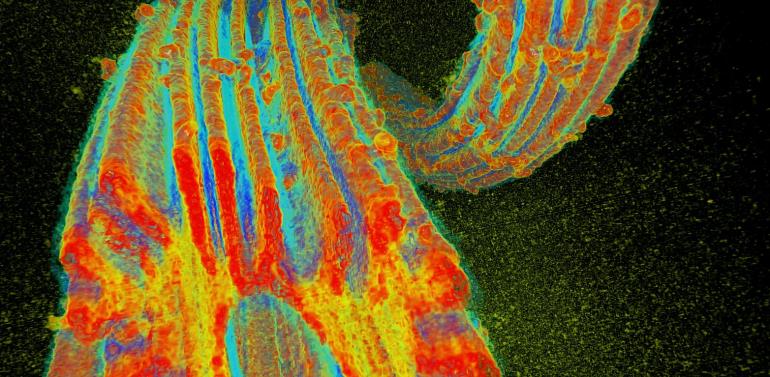International
Advances in extracting uranium from seawater announced

The oceans hold more than four billion tons of uranium — enough to meet global energy needs for the next 10,000 years if only we could capture the element from seawater to fuel nuclear power plants. Major advances in this area were published April 20 by the American Chemical Society’s journal Industrial & Engineering Chemistry Research.
For half a century, researchers worldwide have tried to mine uranium from the oceans with limited success. In the 1990s, Japan Atomic Energy Agency scientists pioneered materials that hold uranium as it is stuck or adsorbed onto surfaces of the material submerged in seawater. In 2011, the Department of Energy initiated a program involving a multidisciplinary team from national laboratories, universities and research institutes to address the fundamental challenges of economically extracting uranium from seawater. Within five years this team has developed new adsorbents that reduce the cost of extracting uranium from seawater by three to four times.
To chronicle this and other successes, the special issue focused on “Uranium in Seawater” amasses research presented by international scientists at ACS’s spring 2015 meeting in Denver. Major contributions came from researchers supported by the Fuel Resources Program of DOE’s Office of Nuclear Energy who coordinate an international effort involving researchers in China and Japan under agreements with the Chinese Academy of Sciences and JAEA. The DOE program is laying the technological foundation to determine the economic feasibility of uranium recovery from seawater. It supports researchers at national laboratories, universities and research institutes focused on developing and testing the next generation of adsorbents that will exhibit higher adsorbent capacity, faster binding and lower degradation over multiple use cycles in seawater.
“For nuclear power to remain a sustainable energy source, an economically viable and secure source of nuclear fuel must be available,” said Phillip Britt, who provides technical and outreach leadership for the DOE program. “This special journal issue captures the dramatic successes that have been made by researchers across the world to make the oceans live up to their vast promise for a secure energy future.”
Scientists from two DOE labs, Oak Ridge National Laboratory in Tennessee and Pacific Northwest National Laboratory in Washington, led more than half of the 30 papers in the special issue. ORNL contributions concentrated on synthesizing and characterizing uranium adsorbents, whereas PNNL papers focused on marine testing of adsorbents synthesized at national labs and universities.
“Synthesizing a material that’s superior at adsorbing uranium from seawater required a multi-disciplinary, multi-institutional team including chemists, computational scientists, chemical engineers, marine scientists and economists,” said Sheng Dai, who has technical oversight of the ORNL uranium from seawater program. “Computational studies provided insight into chemical groups that selectively bind uranium. Thermodynamic studies provided insight into the chemistry of uranium and relevant chemical species in seawater. Kinetic studies uncovered factors that control how fast uranium in seawater binds to the adsorbent. Understanding adsorbent properties in the laboratory is key for us to develop more economical adsorbents and prepare them to grab as much uranium as possible.”
That teamwork culminated in the creation of braids of polyethylene fibers containing a chemical species called amidoxime that attracts uranium. So far, testing has been conducted in the laboratory with real seawater; but the braids are deployable in oceans, where nature would do the mixing, avoiding the expense of pumping large quantities of seawater through the fibers. After several weeks, uranium oxide-laden fibers are collected and subjected to an acidic treatment that releases, or desorbs, uranyl ions, regenerating the adsorbent for reuse. Further processing and enriching of the uranium produces a material to fuel nuclear power plants.
PNNL researchers tested the adsorbents developed at ORNL and other laboratories, including universities participating in the Nuclear Energy University Program, using natural filtered and unfiltered seawater from Sequim Bay in Washington under controlled temperature and flow-rate conditions. Gary Gill, deputy director of PNNL’s Coastal Sciences Division, coordinated three marine testing sites — at PNNL’s Marine Sciences Laboratory in Sequim, Wash., Woods Hole Oceanographic Institution in Massachusetts and the University of Miami in Florida.
-

 Real Estate2 months ago
Real Estate2 months agoAl Mouj Muscat Unveils Azura Beach Residences Phase 2: A New Chapter in Waterfront Living
-

 Leaders Speak1 month ago
Leaders Speak1 month agoDhofar International Development and Investment Company: Driving Sustainable Growth and Strategic Synergies in Oman’s Investment Landscape
-

 Economy1 month ago
Economy1 month agoMaal Card: What Oman’s New National Payment Card Means for Everyday Users
-

 Events1 month ago
Events1 month agoOER Corporate Excellence Awards 2025 Honours Entities and Innovations in Oman
-

 OER Magazines2 months ago
OER Magazines2 months agoOER, October 25
-

 Arts and Culture2 months ago
Arts and Culture2 months agoOminvest and Bait Al Zubair Launch “Future Frames” to Empower Youth through Art and AI
-

 Entertainment2 months ago
Entertainment2 months agoWhere Heritage Meets Haute Couture: Al Sadaa Haute Couture Transforms the Sultanate’s Fashion Scene
-

 News2 months ago
News2 months agoMs. Noor Saldin, Founder of Modern Generation International School, Wins Woman of the Year 2025; School Honored for Empowering Future Female Leaders































You must be logged in to post a comment Login